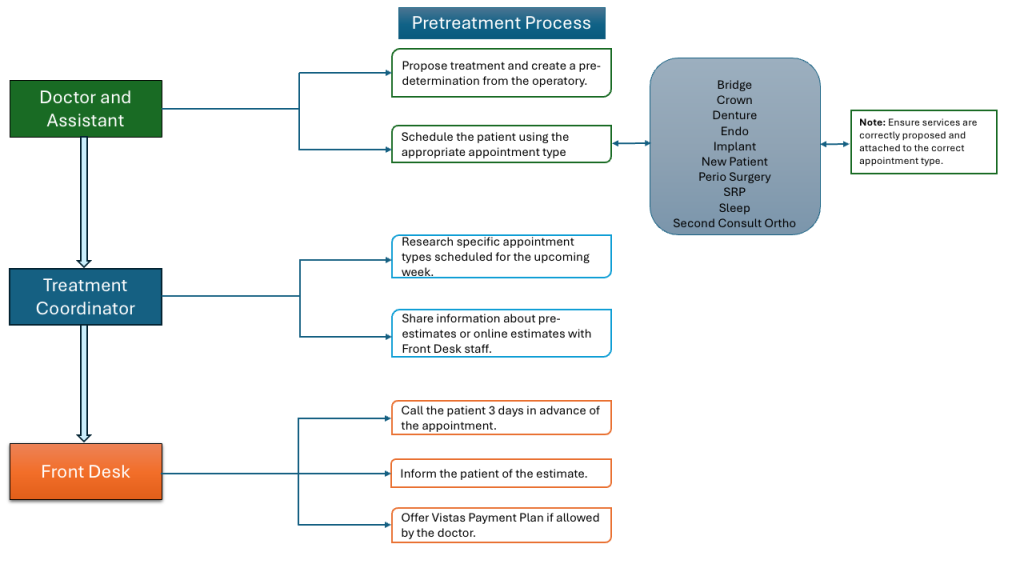Have a system to estimate fees for dental services
There are lots of ways to do this and the most important thing is to have a system that works in a consistent way so the patient has a good patient experience.
Many procedures like fillings are simple to estimate.
Often the benefits with insurance may cover 80%, so the procedure could be done and estimated pretty easily just by doing an estimate in the practice software.
But for more expensive services such as crowns or dentures that go over a certain price level, it’s even more important to be able to accurately estimate those fees for the patient.
An example of a pre-treatment process to estimate fees for the patient
So there is a part for everyone to help in this example. The clinical staff has a role, the treatment coordinator does a part and a there is a role that the front desk does. So let’s start.
It all starts with the patient in the operatory, with the doctor, the hygienist, or the assistant.

Once the exam is done and the treatment plans are made, the treatment plan needs to be presented to the patient, and those service codes need to be entered into the practice management software.
In the operatory, it’s the doctor, the hygienist, the assistant that have discussed the treatment with the patient. After the exam, that information needs to be entered into the computer in the operatory.
A lot of practice management software programs can bundle certain service codes together to create a treatment plan for a particular plan of action such as a bridge, implant, or denture with extractions.
So first, propose the treatment in the operatory and go ahead and send that predetermination to the insurance from the operatory.
If there’s insurance, a lot of software will let you send that information to the insurance with one click of a button.
So go ahead and send that from the operatory so that there’s no delay, and no chance that it doesn’t get sent. Sometimes the insurance responds, sometimes they do not, but at least we have asked.
After you propose and send it, you can confirm with the patient that the office has done their part to send the information to the insurance, in order to ask the insurance about benefits.
The second thing, after proposing treatment and sending it to the insurance, the second thing is to go ahead and schedule the patient using the appropriate appointment type. This may be an appointment type that you later track- such as crown, implant, or SRP’s.
What that means is you need to go ahead and schedule the patient for the treatment. You want to know is the patient serious about the treatment. If they are, go ahead and schedule it.
If there’s some question about what the patient’s part would be as far as treatment fees, then you can assure the patient you will call them before that appointment to update the information.
You could tell them the fees today, but what you don’t know is what the insurance will pay. So before their next visit, you call them and let them know what you think the benefits would be for their insurance if the insurance hasn’t responded.

This shouldn’t slow you down from going ahead and making an appointment to get the patient the care they need.
If the only obstacle is discussing the insurance benefits, it’s important to go ahead and schedule the appointment too, because this gives the office and the patient a deadline by which time to know this information. We need that mutual reminder by when we will have any benefit questions resolved.
The patient needs to know that information about their benefits before that appointment date. And what you don’t want to have happen is to send a letter to the insurance and tell the patient you’ll call them back, and then the insurance never sends the information.
Then you never call the patient and then the patient blames the office for not caring about the treatment or not thinking the treatment’s important because the office never called back.
When, in reality, we just didn’t give ourselves a deadline to follow up and we were still waiting to hear back from the insurance.
You don’t want that to happen. So go ahead and schedule the patient. That way too, you’re finding out benefits for patients who are serious about treatment. If the patient doesn’t want to take the first step toward treatment with the followup appointment- they may not feel comfortable with treatment regardless of the price.

If the patient isn’t interested to take that first step of scheduling an appointment for the first step of the procedure, then they may not even want the treatment.
There may be other obstacles besides just the finances, but if they’re really sold on the idea of doing the treatment and they’re ready to proceed to do something to help them and they just have a question about what their insurance will pay, we can call the patient before the next visit and give them that information.
So from the operatory, propose the treatment, send the predetermination, and then also go ahead and schedule the patient and schedule it in the software in a way that it can be tracked later using a specific appointment type that’s tracked.
Perhaps you schedule it using a crown appointment or a denture appointment, whatever color shows up on the screen, that will help the treatment coordinator later find those appointments to make sure that the information is ready.
Then when the patient leaves, they’re already scheduled to come back. You don’t have to play phone tag with the patient later to schedule an appointment. Maybe the appointment is three to five weeks later. And then in the meantime, the treatment coordinator will start to research different appointment types that are scheduled for the upcoming week or two and they’re looking at those crown appointments, the bridge appointments, the denture appointments, and making sure that the information about insurance benefits is ready.
Did the insurance send a pre-estimate back? If so, the treatment coordinator can read that and make sure that information makes sense and is in the software.
And if the insurance did not respond with a pre-estimate, then the treatment coordinator can call the insurance. Or they can go online and try to estimate benefits in different ways besides waiting for the insurance to send a pre-estimate.
Once all that information is gathered, the treatment coordinator is going to share that with the front desk.
The front desk is the face of the practice that the patient will see when they check in and check out and have to pay.
It’s important to establish that relationship between the front desk and the patient. The treatment coordinator can go ahead and send that information several days to a week in advance of the appointment to the front desk who will be seeing that patient and making sure that the patient knows what the patient’s part will be and what the insurance is estimated to pay.

We can never guarantee what insurance will pay, but we can make our best efforts to estimate by asking the insurance and by calling them and getting what benefit information we can.
So then the front desk will need to call the patient.
Like we said, we told the patient we will call them before the appointment to give them an update on fees. That’s what we need to do is call them at least three to five days in advance of the appointment.
You need to inform the patient of what the estimated amount will be. Again, you can’t guarantee payment, but you can explain what is the treatment fee amount. And to explain what is the estimated insurance benefit and this is what you expect the patient copay will be.
It may be a good idea to let the doctor review all of this before the call is made, if there’s any question, but present that to the patient and let them know what those fees are. We want to be sure the patient is informed and comfortable.
As far as finances, does the doctor allow a payment plan?
In which case calling ahead of the appointment gives time to go ahead and work out the arrangements to set up that payment plan before the appointment.
And if the patient chooses not to do the treatment, they still have time to cancel the appointment.
The aim of this pre-estimate of fees

The goal is to have no surprises for the patient about fees. You don’t want the patient to do a procedure and then have a fee that they didn’t anticipate.
You can’t guarantee what the insurance will pay.
But you can do your best to estimate the fees and let the patient know ahead of time what you think the insurance will do and try to get the best estimate you can before they do the procedure.
In which case there’ll be fewer surprises for the patient later.


